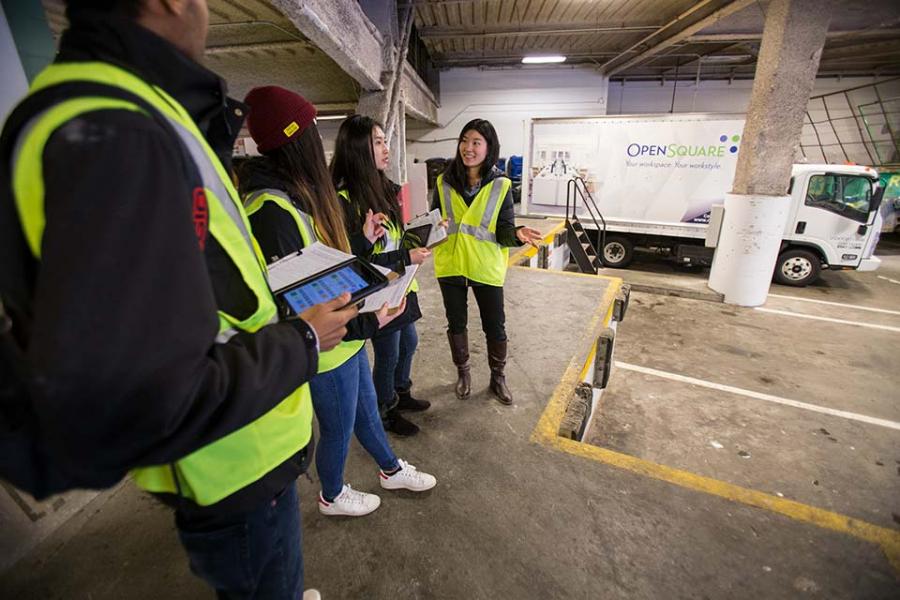
OCTOBER 11, 2018 — Ecommerce is booming, and data shows that the number of packages delivered in Seattle could double in the next five years if online shopping continues to grow at its current rate, increasing the number of delivery vehicles, and impacting congestion, parking, and air quality.
Parcel lockers open to all freight carriers could alleviate the strain. A common carrier locker system would provide drivers with one location to deliver packages. And if the lockers are located in a public space, such as a transit station in a dense neighborhood, residents could retrieve packages at their convenience.
The Urban Freight Lab (UFL)—which investigates and tests low-cost high-value strategies to optimize operations of goods delivery in the final 50 feet of the supply chain—today released the results of a study on the effectiveness of installing such a locker system to reduce the delivery time in urban towers.
The study provides evidence that the common carrier locker system strategy can achieve a significant reduction in delivery time when compared to traditional floor-to-floor door-to-door delivery: the average time truck drivers spent in the tower decreased by 78 percent and failed deliveries decreased to zero.
“We anticipated that if we had a locker system, we would reduce the delivery time,” said Ph.D. student Haena Kim, who led the project’s data collection. “But what we saw was a 78% reduction in time. That’s astonishing.”
“Smart lockers create a mini-distribution node, as do concierges and mailrooms, where drivers make one stop to deliver many packages,” said Barb Ivanov, chief operating officer for the Supply Chain Transportation and Logistics Center. “They do their work faster and park for a shorter amount of time, freeing up city load zones for other users.”
The first demonstration of a common carrier parcel locker system in a public location in the U.S., the pilot was open to the first 100 tenants of the Seattle Municipal Tower who registered to use the lockers from March to April 2018.
UFL researchers collected “before” and “after” data to evaluate the pilot’s premise: that when delivery vehicles can pull into a load/unload parking space that is near a mini-distribution node with delivery density, everyone benefits. All packages delivered by UFL members UPS and the U.S. Postal Service to registered participants were delivered to the locker system.
The pilot also demonstrates the UFL’s unique capability to develop cross-functional business and city working partnerships, gain senior executives’ participation in research, and effectively manage innovative and complex projects that have a high level of uncertainty.
“Reducing the number of failed delivery attempts, as well as the amount of time a delivery truck is parked in a loading space could offer significant public and private benefits,” said Ivanov. “These two actions alone could reduce congestion and free up curb space for cars, buses, bicycles, and other people who need to use that shared public space.”
READ MORE:
- Read the report: The Final 50 Feet Urban Goods Delivery System: Common Carrier Locker Pilot Test at the Seattle Municipal Tower
- About the research project: Common Carrier Locker Pilot Test at the Seattle Municipal Tower
- Photos from Urban Freight Lab Common Carrier Pilot Project launch
About the Urban Freight Lab (UFL): An innovative public-private partnership housed at the Supply Chain Transportation & Logistics Center at the University of Washington, the Urban Freight Lab is a structured workgroup that brings together private industry with City transportation officials to design and test solutions around urban freight management.
About the Final 50 Feet Research Program: The Urban Freight Lab’s Final 50 Feet research program designs and tests solutions to improve delivery at the end of the supply chain—beginning at a load/unload parking space at the curb, in an alley, or in a private loading bay, and maneuvering through sidewalks, intersections, and building security, and ending when the customer takes possession.
In the media:
- AASHTO Journal: University Hopes to Spearhead Seattle Parcel Locker Pilot as Part of Congestion Reduction Plan
- City Logistics: Lessons learned from common carrier lockers systems in Seattle
- Fleet Owner: Making it through the metropolitan delivery maze
- Parcel Pending: New Study Shows Parcel Pending Lockers Significantly Reduced Failed Deliveries and Delivery Truck Parking Time
- Sidewalk Talk: Outside the box truck: Innovations in delivery that could change our cities